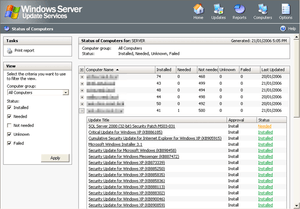Windows Server Update Services
| A component of Windows Server | |
|---|---|
 WSUS can display precise information about which updates each client needs | |
| Details | |
| Type | Package management, remote administration |
| Included with | Windows Server 2003 R2 and later |
| Also available for | Windows Server 2003[1] |
| Related components | |
| Windows Update, Windows Store | |
Windows Server Update Services (WSUS), previously known as Software Update Services (SUS), is a computer program developed by Microsoft Corporation that enables administrators to manage the distribution of updates and hotfixes released for Microsoft products to computers in a corporate environment. WSUS downloads these updates from the Microsoft Update website and then distributes them to computers on a network. WSUS is an integral component of Windows Server.
History
The first version of WSUS was known as Software Update Services (SUS).[2] At first, it only delivered hotfixes and patches for Microsoft operating systems. SUS ran on a Windows Server operating system and downloaded updates for the specified versions of Windows from the remote Windows Update site which was operated by Microsoft. Clients could then download updates from this internal server, rather than connecting directly to Windows Update.[3] Support for SUS by Microsoft was originally planned to end on December 6, 2006, but based on user feedback, the date was extended to July 10, 2007.[4]
WSUS builds on SUS by expanding the range of software it can update. The WSUS infrastructure allows automatic downloads of updates, hotfixes, service packs, device drivers and feature packs to clients in an organization from a central server(s).
Operation
Windows Server Update Services 2.0 and above comprise a repository of update packages from Microsoft. It allows administrators to approve or decline updates before release, to force updates to install by a given date, and to obtain extensive reports on which updates each machine requires. System administrators can also configure WSUS to approve certain classes of updates automatically (critical updates, security updates, service packs, drivers, etc.). One can also approve updates for "detection" only, allowing an administrator to see which machines will require a given update without also installing that update.
Administrators can use WSUS with Group Policy for client-side configuration of the Automatic Updates client, ensuring that end-users can't disable or circumvent corporate update policies. WSUS does not require the use of Active Directory; client configuration can also be applied by local group policy or by modifying the Windows registry.
WSUS uses .NET Framework, Microsoft Management Console and Internet Information Services. WSUS 3.0 uses either SQL Server Express or Windows Internal Database as its database engine, whereas WSUS 2.0 uses WMSDE. System Center Configuration Manager (SCCM) interoperates with WSUS and can import third party security updates into the product.[5]
Version history
| Version | Date | Comments |
|---|---|---|
| 2.0 Release Candidate | March 22, 2005 | |
| 2.0 | June 6, 2005 | |
| 2.0 Service Pack 1 | May 31, 2006 | Adds support for Windows Vista clients, additional client languages, and using Microsoft SQL Server 2005 as a database backend, as well as performance improvements with the web-based user interface |
| 3.0 Beta 2 | August 14, 2006 | MMC based UI and loads of new features |
| 3.0 Release Candidate | February 12, 2007 | |
| 3.0 | April 30, 2007 | WSUS 3.0 and WSUS Client 3.0 were made available via WSUS on May 22, 2007[6] |
| 3.0 Service Pack 1 Release Candidate | November 1, 2007 | |
| 3.0 Service Pack 1[7] | February 7, 2008 | |
| 3.0 Service Pack 2 | August 25, 2009 | Part of Windows Server 2008 R2 |
| 4.0[8] | October 26, 2012 | Part of Windows Server 2012 and 2012 R2[8] |
| 5.0[9] | September 26, 2016 | Part of Windows Server 2016[9] |
References
- ↑ "Download: Windows Server Update Services 3.0 SP2". Download Center. Microsoft. August 25, 2009.
Server component cannot be installed on Windows client OS
- ↑ Foust, Mark; Chellis, James; Sheltz, Matthew; Sage London, Suzan (2006). "Chapter 7: Planning Server-Level Security". MCSE Windows Server 2003 network infrastructure planning and maintenance study guide. Hoboken, New Jersey: John Wiley and Sons. p. 532. ISBN 978-0-7821-4450-5.
- ↑ "Software Update Services". Microsoft TechNet. Microsoft Corporation. Retrieved May 4, 2011.
- ↑ Keizer, Gregg (November 16, 2006). "Microsoft Keeps Software Update Services Alive Until July". InformationWeek. UBM TechWeb. Retrieved May 4, 2011.
- ↑ "About System Center Updates Publisher". Microsoft. Retrieved August 11, 2011.
- ↑ Harder, Bobbie (May 22, 2007). "Updates for WSUS available today". WSUS Product Team Blog. Microsoft.
- ↑ Cole, Cecilia (February 7, 2008). "WSUS 3.0 SP1 is now RTM". WSUS Product Team Blog. Microsoft.
- 1 2 Henry, Steve (September 15, 2016). "Update on WSUS 3.0 SP2 End of Life". WSUS Product Team Blog. Microsoft.
- 1 2 Henry, Steve (March 2, 2018). "WSUS Catalog import failures". WSUS Product Team Blog. Microsoft.
External links
- Official website on Microsoft Docs
- WSUS Product Team Blog